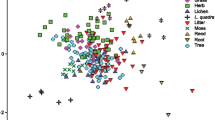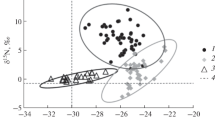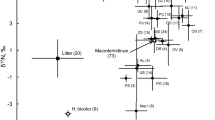Summary
Stable carbon isotope ratio analysis is a powerful technique in tracing ecosystem carbon flows, especially those between primary and secondary producers. The distinctive 13C/12C ratios of plant species tend to pass along the food chain with little further fractionation, hence the stable carbon isotope composition of an animal is an important clue to what it has eaten. We compared the stable carbon isotope composition of plants and insects in an old field in Georgia. Of the dominant plants in the old field, 6 were C4 species and had δ13C1 values of-10.9‰ to 12.9‰, and 7 were C3 species with values of-27.3‰ to-29.1‰. Insects known to be feeding on only one plant species had δ13C values within 1‰ of the isotopic composition of the plant. Wasp larvae parasitizing two insect species had δ13C values 1.3 and 1.7‰ higher than that of the food plant. A variety of insects of unknown food habits collected on monospecific and mixed species plant stands in the old field had δ13C values ranging from-10.1‰ to-30.0‰. Two species of leafhopper and a grasshopper had isotopic compositions within the range of C4 plant values; a tortoise beetle and a lace bug had isotopic compositions within C3 plant values. Other insects had intermediate δ13C values, suggesting a mixed diet composed of both C3 and C4 plants. The carbon isotopic ratios of field collected insects appears to be a useful qualitative indicator of their feeding preference.
Similar content being viewed by others
References
Ashby, J.W.: A study of arthropod predation of Pieris rapae L. using serological and exclusion techniques. J. Appl. Ecol. 11, 419–425 (1974)
Baldwin, W.F., James, H.G., Welch, H.E.: A study of predators of mosquito larvae and pupae with a radio-active tracer. Canad. Ent. 87, 350–356 (1955)
Caswell, H., Reed, F., Stevenson, S.N., Werner, P.A.: Photosynthetic pathways and selective herbivory: A hypothesis. Am. Nat. 107, 465–580 (1973)
Crossley, D.A., Howden, H.F.: Insect-vegetation relationships in an area contaminated by radioactive wastes. Ecology 42, 302–317 (1961)
Crossley, D.A., Merchant, V.A.: Feeding by Caeculid mites on fungus demonstrated with radioactive tracers. Ann. Ent. Soc. Amer. 64, 760–762 (1971)
de la Cruz, A.A., Wiegert, R.G.: 32-Phosphorus tracer studies of a horseweed-aphid-ant food chain. Amer. Midl. Nat. 77, 501–509 (1967)
Dempster, J.P.: A quantitative study of the predators on the eggs and larvae of the broom beetle, Phytodecta olivacea Forster, using the precipitin test. J. Anim. Ecol. 29, 149–167 (1960)
Dempster, J.P.: The feeding habits of the Miridae (Heteroptera) living on broom (Sarothamnus scoparius (L.) Wimm.). Ent. exp. appl. 7, 149–154 (1964)
Dempster, J.P.: Arthropod predators of the Miridae (Heteroptera) living on broom (Sarothamnus scoparius). Ent. exp. appl. 9, 405–412 (1966)
Dempster, J.P.: The control of Pieris rapae with DDT. I. The natural mortality of the young stages of Pieris. J. Appl. Ecol. 4, 485–500 (1967)
DeNiro, M.J., Epstein, S.: Influence of diet on the distribution of carbon isotopes in animals. Geochim. Cosmochim. Acta 42, 495–506 (1978a)
DeNiro, M.J., Epstein, S.: Carbon isotopic evidence for different feeding patterns in two hyrax species occupying the same habitat. Science 201, 906–908 (1978b)
Downton, W.J.S.: The ocurrence of C4 photosynthesis among plants. Photosynthetica 9, 96–105 (1975)
Fox, C.J.S., MacLellan, C.R.: Some Carabidae and Staphylinidae shown to feed on a wireworm, Agriotes sputator (L.), by the precipitin test. Canad. Ent. 88, 228–231 (1956)
Fry, B., Joern, A., Parker, P.L.: Grasshopper food web analysis: use of carbon isotope ratios to examine feeding relationships among terrestrial herbivores. Ecology 59, 498–506 (1978)
Haines, E.B., Montague, C.L.: Food sources of estuarine invertebrates analysed using 13C/12C ratios. Ecology, in press
Isely, F.B., Alexander, G.: Analysis of insect food habits by crop examination. Science 109, 115–116 (1949)
Kiritani, K., Kawahara, S., Sasaba, T., Nakasugi, F.: Quantitative evaluation of predation by spiders on the green rice leafhopper, Nephotettix cincticeps Uhler, by a sight-count method. Res. Pop. Ecol. 13, 187–200 (1972)
Laughton, B.G., Derry, C., West, A.S.: Spiders and the spruce budworm. In: The dynamics of epidermic spruce budworm populations (R.F. Morris, ed.), pp. 249–268. Ent. Soc. Mem. 31, (1963)
Marples, T.G.: A radionuclide tracer study of arthropod food chains in a Spartina salt marsh ecosystem. Ecology 47, 270–277 (1966)
Mulkern, G.B., Anderson, J.F.: A technique for studying the food habits and preferences of grasshoppers. J. Econ. Ent. 52, 342 (1959)
Odum, E.P., Kuenzler, E.J.: Experimental isolation of food chains in an old-field ecosystem with the use of phosphorus-32. In: Radioecology. (V.C. Schultz and A.W. Klement, Jr. ed.), pp. 113–120. London: Chapman and Hall (1963)
Odum, E.P., Golley, F.B.: Radioactive tracers as an aid to the measurement of energy flow at the population level in nature. In: Radioecology (V.C. Schultz and P.W. Clement, Jr., eds.), pp. 403–410. London: Chapman and Hall (1963)
Parker, P.L.: The biochemistry of the stable isotopes of carbon in a marine bay. Geochim. Cosmochim. Acta 28, 1155–1164 (1964)
Pimental, D.: Competition and the species-per-genus structure of communities. Ann. Ent. Soc. Am. 54, 323–333 (1961)
Putnam, W.L.: Occurrence and food of some Coccinelids (Coleoptera) in Ontario peach orchards. Canad. Ent. 96, 1149–1155 (1964)
Putnam, W.L.: Paper chromatography to detect predation on mites. Canad. Ent. 97, 435–441 (1965)
Putnam, W.L.: Prevalence of spiders and their importance as predators in Ontario peach orchards. Canad. Ent. 99, 160–170 (1967)
Rothschild, G.H.L.: A study of a natural population of Conomelus anceps (Germar) (Homoptera: Delphacidae) including observations on predation using the precipitin test. J. Anim. Ecol. 35, 413–434 (1966)
Smith, B.N.: Natural abundance of the stable isotopes of carbon in biological systems. Bioscience 22, 226–231 (1972)
Smith, B.N., Epstein, S.: Two categories of 13C/12C ratios for higher plants. Plant Physiol. 47, 380–384 (1971)
Thayer, G., Parker, P., La Croix, M., Fry, B.: The stable carbon isotope ratio of some components of an eelgrass Zostera marina Bed. Oecologia 35, 1–12 (1978)
Wiegert, R.G., Evans, F.C.: Investigations of secondary productivity in grassland. In: Secondary Productivity of Terrestrial Ecosystems (K. Petrusewicz, ed.), pp. 499–518. Warsaw: Panstwowe Wydawnictwo Naukowe (1967)
Wiegert, R.G., Odum, E.P., Schnell, J.H.: Forb-arthropod food chains in a one-year experimental field. Ecology 48, 75–83 (1967)
Wieres, R.W., Chiang, H.C.: Integrated control prospects of major cabbage insects pest in Minnesota. Based on the faumistic, host varietal, and trophic relationships. Minn. Ag. Exp. Stat. Bull. 291, 1–42 (1973)
Author information
Authors and Affiliations
Rights and permissions
About this article
Cite this article
Petelle, M., Haines, B. & Haines, E. Insect food preferences analysed using 13C/12C ratios. Oecologia 38, 159–166 (1979). https://doi.org/10.1007/BF00346561
Received:
Issue Date:
DOI: https://doi.org/10.1007/BF00346561




